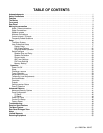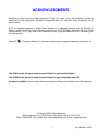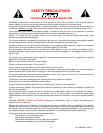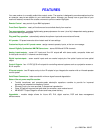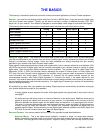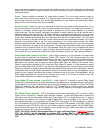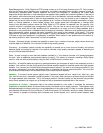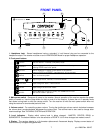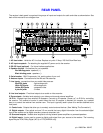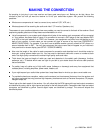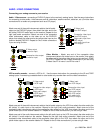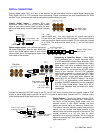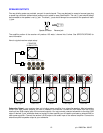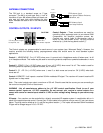
your center channel speaker, but your receiver can produce mono in two or four channels (see “Surround
Mode”). Since all modern sources are stereo, the mono information is usually replicated on both the left
and right channels.
Stereo - Stereo contains two discrete, full range audio channels. This is the most common format for
music and is also used on many movies. You may get stereo from any source - digital or analog. Sound
will normally come only from your front left and right speakers, but your receiver can additionally produce
stereo in four or five channels (see “Surround Mode”).
Dolby Pro Logic - Dolby Pro Logic is a refinement of Dolby Surround which was the earliest form of true
surround processing. Like Stereo, Dolby Surround contains two discrete, full range audio channels. In
addition, a monaural, limited range rear channel is encoded on the two stereo channels in a process
called matrixing. The rear channel information is encoded in positive polarity on the left channel and in
negative polarity on the right channel. The Dolby Processor can detect this encoding (left minus right) and
send that information to the rear channels. Dolby Pro Logic adds additional processing to produce a full
range center channel by extracting the mono information from the left and right channel. This is the most
common format for all but the most recent movies. Music sources are occasionally encoded in Pro Logic.
However, many people prefer to use Pro Logic processing on all of their stereo sources. The center
channel extraction process often yields improved stereo imaging, especially when you are sitting away
from the “sweet spot” at center of the listening area. The rear channel processing often lends a pleasing
ambiance even to material that is not Pro Logic encoded. Dolby Pro Logic is fully compatible with stereo
and you may get it from any source - digital or analog. Sound will normally come from all five speakers in
your system, but your receiver can reduce the number of channels to two or four (see “Surround Modes”).
Dolby Digital (also referred to as AC-3) - Dolby Digital contains up to five discrete, full range audio
channels plus an additional Low Frequency Effects (LFE) channel. The LFE channel contains only low
frequency information for enhanced sound effects in movies. This combination of five discrete channels
plus a LFE channel is often referred to as 5.1 channels. Dolby Digital is a digital format only. It must be
delivered to your receiver over a coaxial or optical digital cable. As of the writing of this manual, Dolby
Digital is commercially available on DVD (Also see
Dolby Digital RF
below). It is also possible to create
your own Dolby Digital CDs and DATs if you have the recording equipment. You can’t directly record Dolby
Digital onto minidisc or digital compact cassette since these devices add their own compression which is
incompatible with the Dolby Digital compression. Sound will normally come from all five speakers in your
system, but your receiver can reduce the number of channels to two or four (see “Surround Mode”). Not all
Dolby Digital recordings will include all five channels, and, in fact, it is common on DVDs to have two
channel Dolby Digital with or without Pro Logic processing.
Dolby Digital RF (also referred to as AC3-RF) - Dolby Digital RF is identical to normal Dolby Digital
except that it uses a special RF encoding scheme to put the bitstream on Laserdiscs without replacing the
normal stereo (or Pro Logic) PCM bitstream that is normally available from laserdisc. In order to use Dolby
Digital RF laserdiscs you must have a B&K DT-1 RF demodulator or similar product from another
manufacturer. For best results with your receivers Plug and Play capability we strongly recommend the
DT-1.
DTS (Digital Theater Systems) - DTS is the latest surround sound technology. DTS is similar to Dolby
Digital in that it provides 5.1 discrete audio channels. However, it uses more digital data to encode the
information and may provide greater fidelity than Dolby Digital. DTS is a digital format only. It must be
delivered to your receiver over a coaxial or optical digital cable. As of the writing of this manual, DTS is
commercially available only on laserdisc and CD with DVD coming soon. No RF demodulator is required
for DTS laserdiscs since the DTS bitstream replaces the normal PCM bitstream. Like Dolby Digital, you
can create your own DTS DATs or CDs but not minidisc or digital compact cassette. As with Dolby Digital,
sound will normally come from all five speakers in your system, but your receiver can reduce the number
of channels to two or four (see “Surround Mode”).
NOTE: The AVR101 series 100 processes Dolby Pro Logic and Dolby Digital, it DOES NOT process
DTS. The AVR101 can be upgraded to process DTS. Contact B&K or your B&K dealer for
information on upgrades. The AVR202 series 200 processes Dolby Pro Logic, Dolby Digital, and
DTS.
5
p/n 12699 Rev. 9812C





